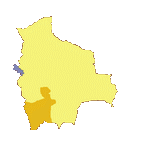Geography
 The province of Sur Lipez is located in the Southern part of the department of
Potosí, at the border with Argentina and Chile.
The province of Sur Lipez is located in the Southern part of the department of
Potosí, at the border with Argentina and Chile.
It is a volcanic area of the cordillera Occidental, and is home to very extensive and
diverse mineral riches. The puna landscapes of the altiplano have disappeared, replaced by
deserts of rocks and salt ![]() , with sulphurous deposits on the sides of volcanoes and multi-coloured water lagoons. Sur Lipez provides
a beautiful festival of colours where the vacuum fills the totality of the space.
, with sulphurous deposits on the sides of volcanoes and multi-coloured water lagoons. Sur Lipez provides
a beautiful festival of colours where the vacuum fills the totality of the space.
San Juan
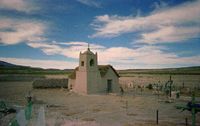 After having crossed the Salar of Uyuni, one
arrives in the Sur Lipez via the small village of
San Juan
After having crossed the Salar of Uyuni, one
arrives in the Sur Lipez via the small village of
San Juan ![]() , one of the last bastions of civilization. The only tourist attraction
of the village is a small chapel in the heart of the cemetery. In the vicinity, one can visit the Chulpas burial sites - the
archaeological reconstruction is sometimes doubtful, but the two mummies and the few bones are genuine enough (from the Chulpas period?).
, one of the last bastions of civilization. The only tourist attraction
of the village is a small chapel in the heart of the cemetery. In the vicinity, one can visit the Chulpas burial sites - the
archaeological reconstruction is sometimes doubtful, but the two mummies and the few bones are genuine enough (from the Chulpas period?).
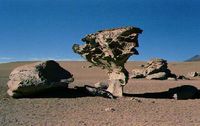 South of the area, the track crosses a great sandy and stony desert, in the middle of which
huge blocks of volcanic rock can occasionally be seen, looking like enormous mushrooms . Their jagged forms are the results of intense
erosion phenomena.
South of the area, the track crosses a great sandy and stony desert, in the middle of which
huge blocks of volcanic rock can occasionally be seen, looking like enormous mushrooms . Their jagged forms are the results of intense
erosion phenomena.
The lagoons
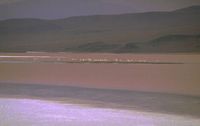 The
lagoons
The
lagoons ![]() spread over a distance of 400km.
The most famous are ,Laguna Hedionda (foul smelling) which draws its name from the
sulphur dioxide emissions, la
Laguna Cañapa
spread over a distance of 400km.
The most famous are ,Laguna Hedionda (foul smelling) which draws its name from the
sulphur dioxide emissions, la
Laguna Cañapa ![]() and its pink flamingos, and
Laguna Colorada
and its pink flamingos, and
Laguna Colorada ![]() (with ochre-red coloured water) where the only camp site in the area is situated.
(with ochre-red coloured water) where the only camp site in the area is situated.
With the development of tourism, the camp site of Laguna Colorada has lost the adventurous charm of the Nineties. A power generating unit ensures lighting up to 20:00h/21:00h every night, one can buy some basic food (though not enough to make a feast!), housing is relatively pleasant for one night (especially after a long day travelling), and, for those with the energy and desire for some evening entertainment, there is even a discotheque!
There are six species of flamingos in the world. Three of them live in the Andean region: Andean flamingo, Chilean flamingo and James flamingo. The flamingos get their color from algae and microorganisms constituting their food. The Chilean flamingos eat small crustaceans from the mud, while the other two species eat microscopic unicellular algae (diatoms) of orange color due to carotene pigments. Like other shorebirds, flamingos sleep upright folding one leg under their feathers. This position requires less energy than staying on two legs, it also allows them to keep one paw warm and to quickly fly in case of danger.
Geysers of Sol de Mañana
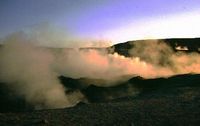 Five o'clock in the morning: a difficult awakening in the camp of
Laguna Colorada for the few courageous tourists. The night is icy cold (-15C), the Milky Way floats in a sky of an
exceptional purity, but the freezing temperature quickly dissipates the charm of this fantastic night. It is necessary
to leave, heading towards the
Geysers of Sol de Mañana
Five o'clock in the morning: a difficult awakening in the camp of
Laguna Colorada for the few courageous tourists. The night is icy cold (-15C), the Milky Way floats in a sky of an
exceptional purity, but the freezing temperature quickly dissipates the charm of this fantastic night. It is necessary
to leave, heading towards the
Geysers of Sol de Mañana ![]() . It is daybreak when one arrives at the site. The first rays of
the morning sun illuminate the smoking craters, from where the loud roars of ebullient water eruptions can be heard.
The colours are fantastic in this lunar landscape, the surrounding mountains cloaked in a reddish colour, the blue
of the waking sky slowly veiling the Moon. Gradually, the fingers thaw on the camera...
. It is daybreak when one arrives at the site. The first rays of
the morning sun illuminate the smoking craters, from where the loud roars of ebullient water eruptions can be heard.
The colours are fantastic in this lunar landscape, the surrounding mountains cloaked in a reddish colour, the blue
of the waking sky slowly veiling the Moon. Gradually, the fingers thaw on the camera...
The hot springs
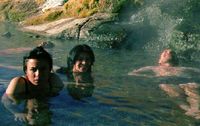 With the 4 wheel drive, the tourists continue their route in the deeper
Sur Lipez. The road passes close to a lagoon with
thermal springs
With the 4 wheel drive, the tourists continue their route in the deeper
Sur Lipez. The road passes close to a lagoon with
thermal springs ![]() . The temperature is negative outside (it is only 9
o'clock in the morning), but no one can refuse a bath in water at 30C! Of course, getting back out is another matter!
. The temperature is negative outside (it is only 9
o'clock in the morning), but no one can refuse a bath in water at 30C! Of course, getting back out is another matter!
La Laguna Verde
 It takes two days of driving to reach our objective: finally here is the famous
Laguna Verde
It takes two days of driving to reach our objective: finally here is the famous
Laguna Verde ![]() ! The area comprises a great number of lagoons of varied colours, but Laguna Verde with remarkable emerald-green
water is certainly the most beautiful lagoon in this adventure. In the background, about 6000m above sea level, one can admire
the majestic Licancabur volcano, which crater hosts in a small frozen lake aquatic the highest ecosystem in the world. The
border with Chile is just behind the Licancabur.
! The area comprises a great number of lagoons of varied colours, but Laguna Verde with remarkable emerald-green
water is certainly the most beautiful lagoon in this adventure. In the background, about 6000m above sea level, one can admire
the majestic Licancabur volcano, which crater hosts in a small frozen lake aquatic the highest ecosystem in the world. The
border with Chile is just behind the Licancabur.
The red color of Laguna Colorada has an organic origin (algae and crustaceans), while the green color of the Laguna Verde is mineral with very high concentration salt and minerals (sulfur, calcium carbonate, arsenic, copper and lead), which makes the water unfit for consumption. The best time to see the Laguna Verde is in the late morning when the water color start changing depending on sunlight and wind. When the shallow water (a few centimeters) of the lagoon become agitated, the small waves generate a white foam on the shore.
